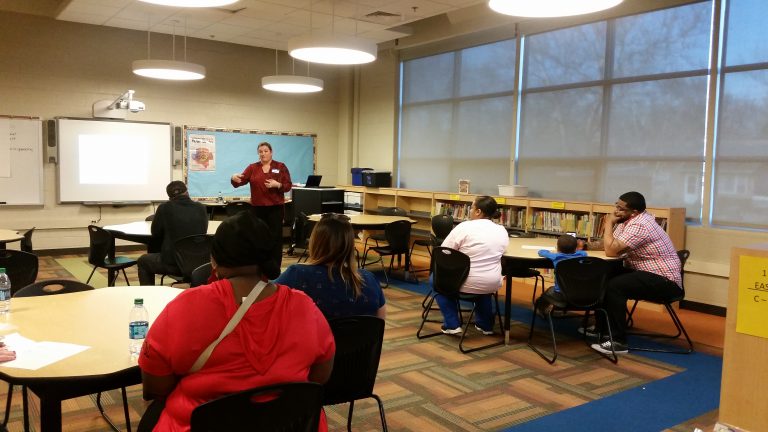Last month, about a dozen people gathered in the basement of a church in Champaign, Ill. to learn how traumatic experiences affect the lives of children and young adults, and what they can do to mitigate its effects.
Karen Simms, a mental health counselor and trauma expert, led the presentation, which was part of a free 40-hour training called “Healing Solutions.”
Most of the adults who attended Simm’s training were educators who say they’re worried about their students.
“Having a caring school environment, me liking school is a protective factor that helps me overcome all kinds of adversity,” Simms explained to the group. “You can go home and have a lot of disruption if eight hours a day somebody likes you. You remove that eight hours a day of people liking you, and that means you have no protection.”
READ NEXT:  Suicides A Driver Of Gun Deaths In Rural America
Suicides A Driver Of Gun Deaths In Rural America
The national conversation around gun violence generally centers around mass shootings, school shootings and gang activity. As Madelyn Beck reports, these problems need to be addressed, but may overshadow the largest group affected: suicide victims.
Read and listen to the story
Educators are worried because children are coming to school with more acute behavioral health issues, Simms said.
“Fights at schools, increased truancy or lots of disruption — it’s not just kids engaging in traditional three to five-year-old behavior, it’s kids raging on the floor for 15 minutes and teachers being injured,” Simms said, in a follow-up interview after the training event. She says untreated trauma often drives this type of behavior.
Exposure to community violence is just one of many causes of trauma, but it was top of mind for Champaign Centennial High School teacher Lindsay Aikman when she showed up for Simm’s training.
Gun violence in the university town has increased in the last seven years, and last December three people were shot outside a high school basketball game.
Aikman told the group at the trauma training about a student she works with who told her he’s experiencing death anxiety.
“And he’s like ‘I feel like I’m gonna die. Like I never felt that way until I became a junior. And now I’m scared of it all the time,’” she said. “I don’t even know what to say to him.”
Kristine Argue, instructional resource and professional development director for the Illinois
Education Association, said the organization has made trauma training for educators and administrators from across the state a priority. The IEA is a statewide union that includes 135,000 teachers and educational support staff. The IEA has delivered trauma training to about 2,500 teachers, administrators, school board members and support staff from across the state, according to IEA spokesperson Bridget Shanahan. Argue says other school districts in other states, like Washington, are further along in their efforts to sensitize school staff and educators to traumatized students. Staff at a Massachusetts school district have spent the last 10 years transitioning to a trauma-informed learning environment.
Roughly two decades worth of research indicates that trauma early in life can dramatically affect a child’s health and academic capabilities. Traumatic stress can change the way developing brains form and function leading to poor health outcomes later in life, including substance abuse, mental and physical health problems, and early death.
“This is a public health crisis,” Argue said. “If we don’t eradicate this public health crisis, it will only fester and get worse.”
The academic future of children who experience traumatic events early in life are also at risk. A study in Chicago showed that children living on the same block where a murder occurred scored lower on reading tests within a week of the homicide.
Aikman said a concern for her student’s futures and the impact that increased violence in the community has had on their well-being brought her to Simms’ training.
“We have kids walking around with chronic PTSD. We have kids repressing the violence they’ve seen, the fear they have of not graduating. We’ve got to do better, there has to be better,” she said.
If the underlying trauma is not addressed, children cannot succeed academically, Simms said. The good news, both Simms and Argue say, is that if educators and communities as a whole implement evidence-based strategies to mitigate the effects of traumatic stress, children can bounce back.
Elizabeth Degruy, director of special education at Champaign Unit 4 School District, began training teachers across the district’s nearly 20 schools to think about their students differently early last year in an effort to mitigate trauma. Like Simms’ training, Degruy says she focuses on the science and how traumatic stress affects the brain.
One of the goals of this type of professional development is to move toward a learning environment “where adults are asking themselves relative to kids behavior not what is wrong with you, but what happened to you,” Degruy said.
Degruy said she’s encountered some resistance to this kind of cultural shift in the classroom. That’s why she says she emphasizes the research behind the best practices when explaining to educators why this approach is in the interest of both the student and the teacher.
“This is not about a touchy feely everybody be nice to each other thing. There is real research, science. This is based in something that is beyond what you might look at as being soft,” Degruy said.
Researchers who study trauma and practitioners like Simms and Argue generally agree that schools should place a greater importance on the social and emotional needs and development of their students — not just their academic performance. Learning environments should be places where every student — regardless of their background — feels safe and supported by the adults at school, they say. Another key component includes shifting from a purely punitive discipline model to a restorative justice system that helps students understand the harm they’ve caused and why they acted that way, teaches better behavior and re-integrates students into the learning community, Simms said.
“When we’re talking about social, emotional things, we are talking about things that will play out for kids for the rest of their lives,” Degruy says. “I value it as being as important as academic learning.”
The most important takeaway for teachers, she explained, “is having strong relationships with all their students, even the ones who ask for it in the worst possible ways.”
But to most effectively improve the lives of youth affected by trauma, Simms said schools, police departments, businesses and local governments should be working together to implement these strategies, to model positive social behavior and provide supportive adult relationships for all children.
“If we don’t have a more collaborative approach to do this work that’s based on science and based on recovery we will leave significant numbers of students behind,” Simms said. “We’re in a state of emergency.”
Argue says building awareness around the science that supports this approach is the first step. But the time it’s taking to do that worries her, too.
“While we’re trying to pull people together, while we’re trying to convince people this is real and it’s not going anywhere, there are tragedies. I mean that figuratively and literally. It scares me,” she said.
But if communities do the work to address these unmet needs, she said, they can steer children away from health problems, prison and early death toward more fulfilling, healthy and productive lives.
NEXT: Suicides A Driver Of Gun Deaths In Rural America
 Illinois Newsroom is a regional journalism collaboration focused on expanding coverage of education, state politics, health, and the environment. The collaborative includes Illinois Public Media in Urbana, NPR Illinois in Springfield, WSIU in Carbondale, WVIK in the Quad Cities, Tri States Public Radio in Macomb, Harvest Public Media and the Midwest Center for Investigative Reporting. Funding comes from the stations and grants from the Corporation for Public Broadcasting (CPB) and McCormick Foundation.
Illinois Newsroom is a regional journalism collaboration focused on expanding coverage of education, state politics, health, and the environment. The collaborative includes Illinois Public Media in Urbana, NPR Illinois in Springfield, WSIU in Carbondale, WVIK in the Quad Cities, Tri States Public Radio in Macomb, Harvest Public Media and the Midwest Center for Investigative Reporting. Funding comes from the stations and grants from the Corporation for Public Broadcasting (CPB) and McCormick Foundation.

